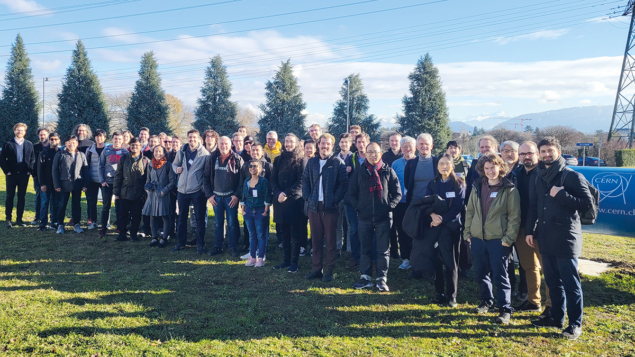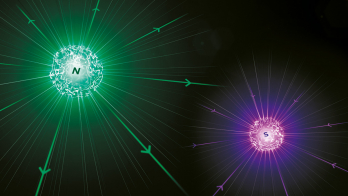
Since their first direct detection in 2015, gravitational waves (GWs) have become pivotal in our quest to understand the universe. The ultra-high-frequency (UHF) band offers a window to discover new physics beyond the Standard Model (CERN Courier March/April 2022 p22). Unleashing this potential requires theoretical work to investigate possible GW sources and experiments with far greater sensitivities than those achieved today.
A workshop at CERN from 4 to 8 December 2023 leveraged impressive experimental progress in a range of fields. Attended by nearly 100 international scientists – a noteworthy increase from the 40 experts who attended the first workshop at ICTP Trieste in 2019 – the workshop showcased the field’s expanded research interest and collaborative efforts. Concretely, about 10 novel detector concepts have been developed since the first workshop.
One can look for GWs in a few different ways: observing changes in the space between detector components, exciting vibrations in detectors, and converting GWs into electromagnetic radiation in strong magnetic fields. Substantial progress has been made in all three experimental directions.
Levitating concepts
The leading concepts for the first approach involve optically levitated sensors such as high-aspect-ratio sodium–cyttrium–fluoride prisms, and semi-levitated sensors such as thin silicon or silicon–nitride nanomembranes in long optical resonators. These technologies are currently under study by various groups in the Levitated Sensor Detectors collaboration and at DESY.
For the second approach, the main focus is on millimetre-scale quartz cavities similar to those used in precision clocks. A network of such detectors, known as GOLDEN, is being planned, involving collaborations among UC Davis, University College London and Northwestern University. Superconducting radio-frequency cavities also present a promising technology. A joint effort between Fermilab and DESY is leveraging the existing MAGO prototype to gain insights and design further optimised cavities.
Regarding the third approach, a prominent example is optical high-precision interferometry, combined with a series of accelerator dipole magnets similar to those used in the light-shining-through-a-wall axion-search experiment, ALPS II (Any Light Particle Search II) or the axion helioscope CAST and its planned successor IAXO. In fact, ALPS II is anticipated to commence a dedicated GW search in 2028. Additionally, other notable concepts inspired by axion dark-matter searches involve toroidal magnets, exemplified by experiments like ABRACADABRA, or solenoidal magnets such as BASE or MADMAX.
All three approaches stand to benefit from burgeoning advances in quantum sensing, which promise to enhance sensitivities by orders of magnitude. In this landscape, axion dark-matter searches and UHF GW detection are poised to work in close collaboration, leveraging quantum sensing to achieve unprecedented results. Concepts that demonstrate synergies with axion-physics searches are crucial at this stage, and can be facilitated by incremental investments. Such collaboration builds awareness within the scientific community and presents UHF searches as an additional, compelling science case for their construction.
The workshop showcased the field’s expanded research interest and collaborative efforts
Cross-disciplinary research is also crucial to understand cosmological sources and constraints on UHF GWs. For the former, our understanding of primordial black holes has significantly matured, transitioning from preliminary estimates to a robust framework. Additional sources, such as parabolic encounters and exotic compact objects, are also gaining clarity. For the latter, the workshop highlighted how strong magnetic fields in the universe, such as those in extragalactic voids and planetary magnetospheres, can help set limits on the conversion between electromagnetic and gravitational waves.
Despite much progress, the sensitivity needed to detect UHF GWs remains a visionary goal, requiring the constant pursuit of inventive new ideas. To aid this, the community is taking steps to be more inclusive. The living review produced after the first workshop (arXiv:2011.12414) will be revised to be more accessible for people outside our community, breaking down detector concepts into fundamental building blocks for easier understanding. Plans are also underway to establish a comprehensive research repository and standardise data formats. These initiatives are crucial for fostering a culture of open innovation and expanding the potential for future breakthroughs in UHF GW research. Finally, a new, fully customisable and flexible GW plotter including the UHF frequency range is being developed to benefit the entire GW community.
The journey towards detecting UHF GWs is just beginning. While current sensitivities are not yet sufficient, the community’s commitment to developing innovative ideas is unwavering. With the collective efforts of a dedicated scientific community, the next leap in gravitational-wave research is on the horizon. Limits exist to be surpassed!








